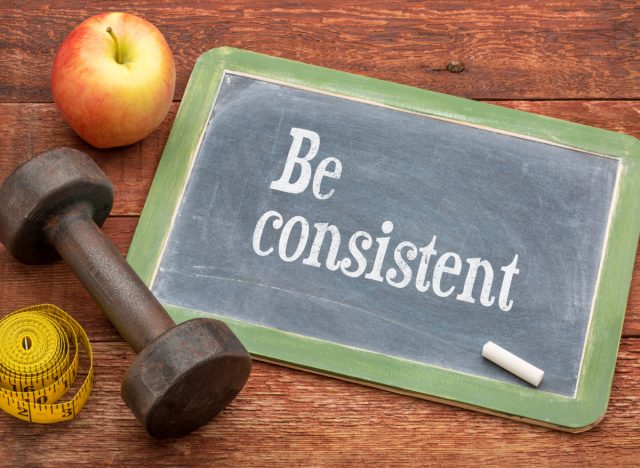A solid strength training regimen is essential to build a stronger, healthier body. However, it’s also important to make sure you’re doing the right things correctly. Eat This, Not That! spoke with Ronny Garcia, CPT, at Blink Fitness, to learn the top strength training rules to follow to achieve the absolute best results.
“Strength training helps build and maintain muscle mass. This enhances your overall strength and function in daily activities, like lifting groceries,” explains Garcia. “Muscles require more energy to maintain than fat, so having more muscle mass can help you burn more calories at rest.”
Productive strength training isn’t simply about challenging yourself to lift high weights and more reps. A well-rounded routine involves so much more, and we’re here with all of the scoop. Keep reading to learn the best strength training rules, and when you’re finished, be sure to check out these 8 Tips for Boosting Muscle Growth After 50, According to a Trainer.
Keep a nutritious diet.

Eating well is a crucial component of an all-around healthy lifestyle. “In order to support muscle growth and recovery you need to fuel your body with the proper nutrients,” explains Garcia. “These include protein, carbs, and healthy fats. Additionally, remember to stay hydrated!”
Set achievable goals.

It’s important to be honest with yourself about setting attainable goals. You always want to challenge yourself, but any challenge must be realistic. “Having clear, trackable, and achievable goals will help you stay motivated throughout your fitness journey,” Garcia adds.
Warm up and cool down properly.

Always get your feet wet, so to speak, before starting any kind of exercise. This gets your muscles and joints ready for the workout you’re about to do. In addition, it’s just as important to cool down when you’re finished. “A cool-down [is necessary] to reduce muscle soreness and promote flexibility,” explains Garcia.
Maintain proper form.

Don’t get caught up in the number of reps you’re trying to achieve over maintaining proper form. As Garcia puts it, “Quality over quantity. Focus on maintaining correct form during each exercise to target the intended muscles, and reduce the risk of injury.”
Implement progressive overload.

Progressive overload is a way of consistently challenging yourself. “Gradually increase the weight, reps, and intensity of your weight over time,” says Garcia. “This challenges the muscles to adapt and grow stronger.”
Work variety into your routine.

Variety is the spice of life and a key ingredient to your workouts. Garcia points out, “Incorporating a variety of exercises that target different muscle groups keeps your workouts engaged, ensures balanced muscle growth, and can prevent plateauing.”
Be consistent.

Consistency is key for every workout you do when you want to see progress. Garcia recommends sticking to a solid schedule and remaining committed to your end goal.
Be sure to rest.

Proper rest and recovery are essential in order for your muscles to repair and grow after exercise. Garcia strongly advises, “Get adequate rest between workouts—this includes getting enough sleep each night. Prioritize recovery to prevent overtraining.”
Allow yourself recovery days.

You need time off from work, and your body needs time off from your workouts! Be sure to carve out recovery days. “If you want to move on your recovery day, try active recovery like light stretching or low-intensity exercise like yoga,” suggests Garcia.
Be mindful of what your body is telling you.

When you’re working out, if something you’re doing doesn’t feel quite right or is painful, it’s time to stop and assess the situation. It’s always wise to check in with a healthcare professional if you think you’ve hurt something and work with a certified trainer who can safely help you design a routine that’s right for you.
Alexa Mellardo









